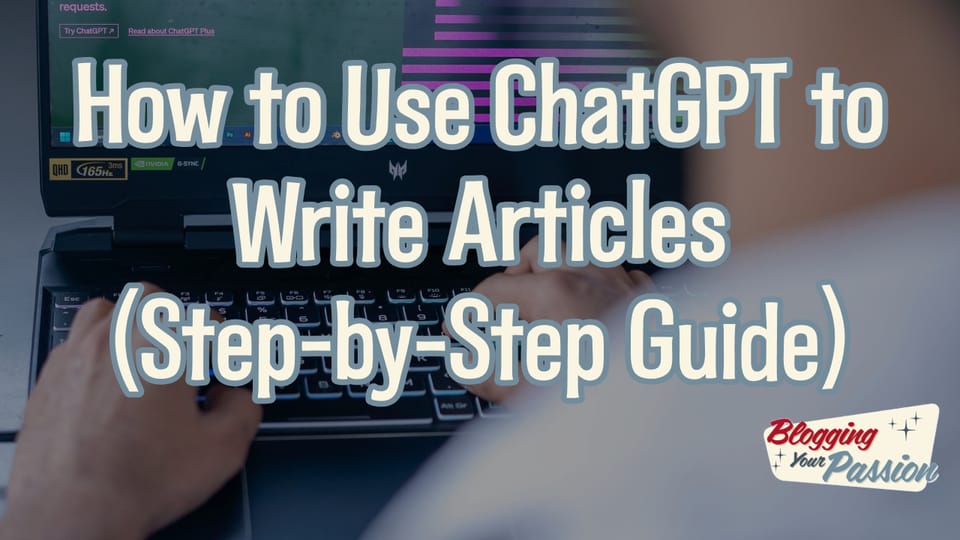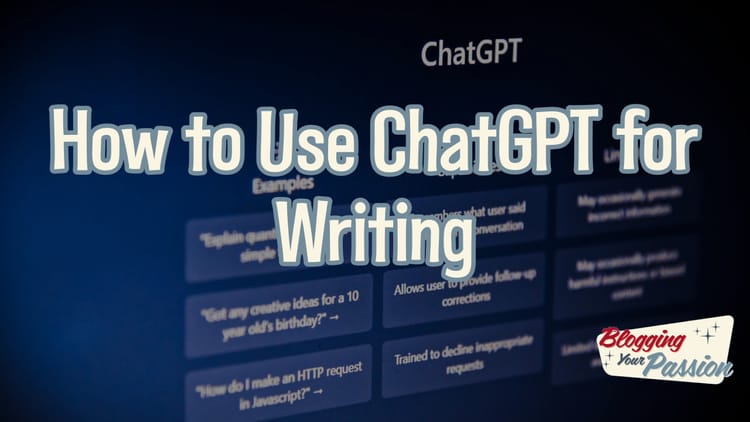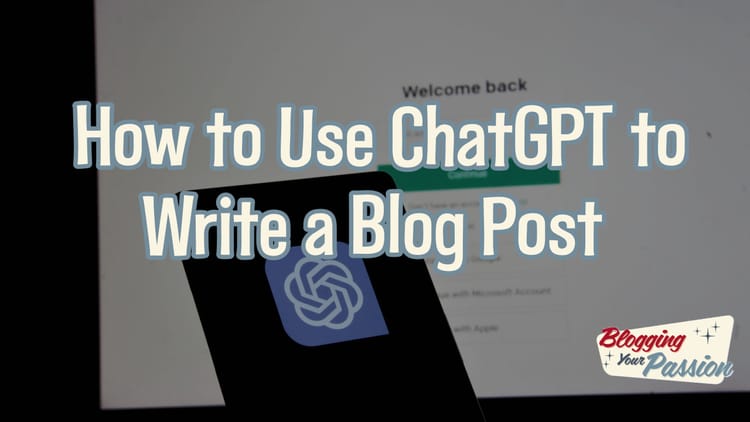How to Use ChatGPT to Write Articles (Step-by-Step Guide)

As a writer, I often find myself grappling with the challenge of creating engaging and well-crafted articles.
However, what if I told you that there is a tool that can assist in streamlining the writing process while maintaining the authenticity of my work?
Enter ChatGPT, a powerful language model that has revolutionized the way I approach article writing.
By leveraging the capabilities of ChatGPT, I have discovered a range of techniques and strategies that have significantly enhanced the quality and efficiency of my writing.
So, how exactly can ChatGPT be utilized to elevate your article writing game? Allow me to share some invaluable insights that will undoubtedly leave you eager to uncover the potential of this remarkable tool.
Table of Contents (click to expand)
Key Takeaways
- Tailor the language and tone of the prompts to effectively communicate intentions to ChatGPT and resonate with the audience.
- Break down the main topic into subtopics and arrange them logically for a structured flow of information.
- Use ChatGPT as a step-by-step guide to generate content and organize ideas for a solid draft.
- Check for plagiarism to ensure the originality and integrity of your content, while demonstrating ethical writing practices.
How to Use ChatGPT to Write Blog Posts
I recently sat down and recorded my exact process from start to finish in this YouTube video.
Craft Effective Prompts with ChatGPT
Crafting effective prompts with ChatGPT requires careful consideration of the language used and a focus on clarity and precision.
As an AI chatbot designed to assist in the writing process, ChatGPT can be a valuable tool for bloggers and content creators looking to enhance their writing style and improve the overall quality of their content.
When creating prompts, it's important to keep in mind the specific goals of the blog post or article and tailor the language accordingly. A well-crafted prompt should provide clear direction and guidance to the writer.
It should be concise and specific, outlining the desired outcome or objective of the piece.
By using precise language, the writer can effectively communicate their intentions to ChatGPT and receive more accurate and relevant responses.
Furthermore, it's important to consider the tone and style of the content being created. ChatGPT can adapt to different writing styles, whether it be formal, conversational, or technical.
By incorporating the appropriate tone into the prompts, the writer can ensure consistency throughout the article and create a sense of belonging for their audience.
Outline Your Article Using ChatGPT
To effectively outline my article with ChatGPT, I find it helpful to first brainstorm key points and organize them in a logical order.
ChatGPT is a powerful tool for content creators, offering a step-by-step guide to generating content.
Here's how I outline my articles using ChatGPT:
- Identify the main topic: Start by clearly defining the central theme of your article. This will help you stay focused and ensure your content is cohesive.
- Break it down into subtopics: Divide your main topic into smaller sections or subtopics. This will make it easier to cover all relevant aspects of your article and provide a structured flow of information.
- Arrange the subtopics: Once you have your subtopics, arrange them in a logical order. Consider the natural progression of ideas or a chronological sequence, depending on what suits your article best.
- Add supporting points: For each subtopic, brainstorm supporting points or arguments. These points will strengthen your article and provide valuable insights to your readers.
Write a Solid Draft Using ChatGPT
Now that I've outlined my article using ChatGPT, it's time to dive into the next step: crafting a solid draft with the help of this powerful tool. Writing a solid draft is crucial to ensure that your article is well-structured and conveys your message effectively.
With ChatGPT, you can generate high-quality content that resonates with your readers.
To begin, start by using ChatGPT to expand on each section of your outline. Ask the model for suggestions, ideas, and supporting details that will enhance your article's flow and coherence.
ChatGPT can provide valuable insights and help you flesh out your ideas in a more comprehensive manner.
As you use ChatGPT to write your draft, keep in mind the importance of maintaining a clear and concise writing style. Be mindful of your audience's desire for belonging by using inclusive language and addressing their concerns.
By incorporating the keywords 'ChatGPT,' 'write articles,' 'solid draft,' 'use ChatGPT,' and 'article section' effectively, you can optimize your content for search engine visibility and reader engagement.
Refine Your Draft
After expanding on each section of my outline with the help of ChatGPT, I find it essential to refine my draft to ensure a polished and cohesive article. Refining your draft is a crucial step in the content writing process, as it helps you shape your original ideas and make them more engaging and impactful.
Here are four key steps to refine your draft and create a long-form article that resonates with your audience:
- Trim the fat: Remove any unnecessary information or repetitive content that may distract your readers from the main message. By streamlining your article, you create a more focused and enjoyable reading experience.
- Enhance readability: Break up long paragraphs into shorter ones and use subheadings to organize your ideas. This improves the flow of your article and makes it easier for your audience to navigate and comprehend.
- Inject personality: Infuse your writing with your unique voice and perspective. This helps establish a connection with your readers and makes them feel like they belong to a community that shares their interests.
- Check for coherence: Ensure that your ideas flow logically from one paragraph to another. Use transitional words and phrases to guide your readers smoothly through your article, creating a seamless reading experience.
Check for Plagiarism
Upon completing the refinement process, it's essential to check for plagiarism in order to ensure the originality and integrity of the article.
With the help of ChatGPT, writing articles has become more efficient and convenient. However, it's crucial to be vigilant and ensure that the content produced is unique and not copied from other sources.
ChatGPT, powered by artificial intelligence, is a powerful tool that assists writers in generating creative and engaging content. It provides suggestions, improves clarity, and helps organize thoughts.
But as responsible writers, we must be cautious about unintentionally incorporating someone else's work into our own.
To check for plagiarism, there are several online tools available that can scan your article and compare it to a vast database of published works. These tools can detect similarities and highlight any potential instances of plagiarism.
By using these tools, we can identify and rectify any unintentional violations of intellectual property rights.
As we strive to create high-quality articles, it's important to maintain the integrity of our work. Checking for plagiarism ensures that our content is original, reliable, and trustworthy.
It also demonstrates our commitment to ethical writing practices and respect for others' intellectual property.
Revise and Finalize
Once the article has been checked for plagiarism, it's important to revise and finalize the content to ensure its clarity and accuracy. This step is crucial in creating high-quality content that resonates with our audience, who desires a sense of belonging.
To evoke an emotional response and engage our readers, here are four key aspects to focus on during the revision process:
- Search engine optimization: Review the article to ensure it's optimized for search engines. Incorporate relevant keywords and phrases naturally throughout the content to enhance its visibility and reach.
- Original content: Double-check that the article offers a unique perspective or valuable information. Authenticity is key to building trust and loyalty with our readers.
- Sentence structure: Pay attention to the flow and structure of sentences. Ensure they're clear, concise, and easy to read. Well-structured sentences make the content more accessible and enjoyable.
- Overcoming writer's block: If you encounter any areas that feel weak or incomplete, take the time to brainstorm, research, and develop those sections further. Overcoming writer's block will result in a more comprehensive and engaging article.
Frequently Asked Questions
Can Chatgpt Generate Code or Programming Solutions?
Yes, Chatgpt has the capability to generate code and programming solutions. It can understand programming languages and provide relevant solutions, making it a valuable tool for developers and programmers.
How Can Chatgpt Be Used to Improve Creative Writing Skills?
Improving creative writing skills with ChatGPT can be done by utilizing its ability to generate ideas, provide feedback, and offer alternative perspectives. It's a valuable tool for honing my craft and expanding my creative horizons.
Can Chatgpt Help With Language Translation or Interpretation?
ChatGPT can indeed help with language translation and interpretation. It has the ability to understand and generate text in multiple languages, making it a useful tool for bridging language barriers and aiding in communication across different cultures.
Are There Any Limitations or Biases to Be Aware of When Using Chatgpt?
There are limitations and biases to be aware of when using Chatgpt. It may generate incorrect or biased information and lacks the ability to fact-check. It's important to critically evaluate and verify the output.
Is It Possible to Use Chatgpt to Generate Content in Multiple Languages?
Yes, it is possible to use ChatGPT to generate content in multiple languages. It can be a valuable tool for creating articles in different languages, expanding your reach and connecting with diverse audiences.
What is the best way to craft effective prompts to get the best results from ChatGPT when generating content?
You'll want to provide relevant topics and context to guide the AI to produce useful, human-like text.
How can I use ChatGPT to help outline blog articles and long-form content?
ChatGPT can help develop section headers and bullet points to draft the structure for various topics. Refine the AI's outline before moving to the next step.
What steps should I take to refine AI-generated text to prepare it for publication?
Review the content critically, watch for grammar mistakes, check for plagiarism, enhance clarity as needed, and revise areas that lack expertise or relevance.
Should I disclose when part of an article is AI-generated?
Transparency is key. Clearly label any AI-generated sections in your own writing. Follow editorial guidelines and inform readers when content comes from new AI tools like ChatGPT.
What limits should I set when using ChatGPT for content creation?
No raw ChatGPT output should go straight to publication. Plan to spend time refining and editing to improve quality. Combine the AI's capabilities with your own expertise and writing. Set word limits on ChatGPT's assistance to retain control.
Conclusion
In conclusion, ChatGPT represents an exciting new AI language model that can assist in various aspects of content creation, from outlining to drafting full articles.
However, it is not a replacement for human writers and critical thinking. When used appropriately as one tool among many to inform and inspire — while applying strict guidelines around editing, citations, transparency and more — ChatGPT can enable writers to create reasonably good copy with greater efficiency.
We advise setting limits on its role and combining its capabilities with your own expertise, research materials from credible sources, and good judgment.
While AI promises to revolutionize how we gather information and synthesize it to engage wider audiences, we have only begun to explore constructive ways ChatGPT and similar natural language AI tools may enhance, but not replace, thoughtful communication.





